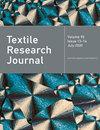女式渐进式压缩运动紧身裤的优化设计
IF 1.9
4区 工程技术
Q2 MATERIALS SCIENCE, TEXTILES
引用次数: 0
摘要
在这项研究中,我们优化设计了一系列具有分级压力的运动紧身裤 O1/O2/O3,评估了人体模型静态、四个受试者静态和动态的敷料压力,并与商用 L 牌运动紧身裤 L1/L2/L3 进行了比较。结果表明,优化设计的运动紧身裤在腰部、腹部和臀部的敷料压力均低于商用运动紧身裤,其中在压力显著的臀部点 P8 处,人体模型静态、四个受试者静态和动态的敷料压力分别降低了 2.34%-14.02%、16.26%-21.78% 和 5.26%-11.88%。从腹股沟到踝关节的四个圆周方向 P4-7、P9-12、P13-16 和 P17-20 的压力呈分级趋势,而商业运动紧身裤的压力波动无明显规律。此外,在静态和动态敷料中,O1/O2/O3 的血流量均高于裸穿时和 L1/L2/L3 的血流量。随着时间的推移,血流量呈下降趋势,但 O1/O2/O3 的血流量仍然比较大,尤其是 O1(76.671 PU,64.054 PU)在两个时间阶段都有明显的动态血流量,对促进腿部血液循环有积极作用。L1/L2/L3的小腿内侧P15血流量低于裸体时,这种情况可能会抑制腿部血流量,导致人体腿部疲劳感增加,不利于体育锻炼和人体健康。本文章由计算机程序翻译,如有差异,请以英文原文为准。
Optimized design of women’s graduated compression sports leggings
In this study, we optimized design of a series of sports leggings O1/O2/O3 with graded pressures, evaluated a mannequin static, four-subjects static and dynamic dressing pressure, and compared with the commercial L-brand sports leggings L1/L2/L3. The results showed that the optimized design sports leggings had lower dressing pressure at the waist, abdomen, and hip than the commercial sports leggings, in which the dressing pressure of a mannequin static, four-subjects static and dynamic at the pressure-significant hip point P8 were reduced by 2.34–14.02%, 16.26–21.78%, and 5.26–11.88%, respectively. The four circumferential directions P4–7, P9–12, P13–16, and P17–20 from the groin to the ankle showed graded pressure trends, while the pressure of commercial sports leggings fluctuated with no significant pattern. In addition, the blood flow of O1/O2/O3 was higher than that of when naked and L1/L2/L3 in both static and dynamic dressing. The blood flow showed a decreasing trend with time, but O1/O2/O3 still had a relatively large blood flow, especially wearing O1 (76.671 PU, 64.054 PU) had a significant dynamic blood flow in both time stages, which had a positive effect on the promotion of blood circulation of the legs. L1/L2/L3 had lower blood flow in the inner calf P15 than when naked, a condition that may inhibit blood flow in the legs and lead to increased fatigue in the human legs, which is detrimental to physical exercise and human health.
求助全文
通过发布文献求助,成功后即可免费获取论文全文。
去求助
来源期刊

Textile Research Journal
工程技术-材料科学:纺织
CiteScore
4.00
自引率
21.70%
发文量
309
审稿时长
1.5 months
期刊介绍:
The Textile Research Journal is the leading peer reviewed Journal for textile research. It is devoted to the dissemination of fundamental, theoretical and applied scientific knowledge in materials, chemistry, manufacture and system sciences related to fibers, fibrous assemblies and textiles. The Journal serves authors and subscribers worldwide, and it is selective in accepting contributions on the basis of merit, novelty and originality.
 求助内容:
求助内容: 应助结果提醒方式:
应助结果提醒方式:


